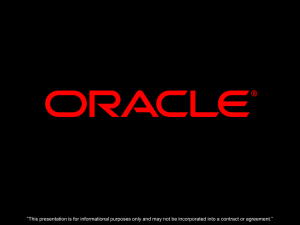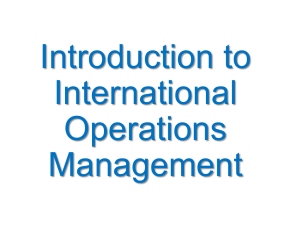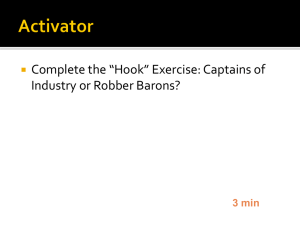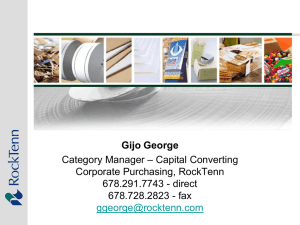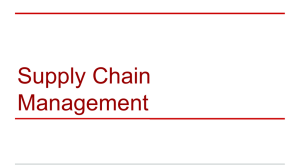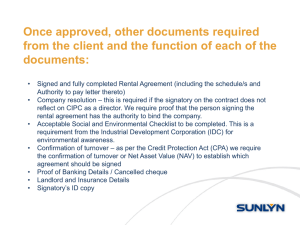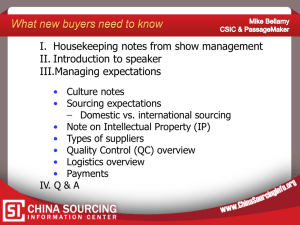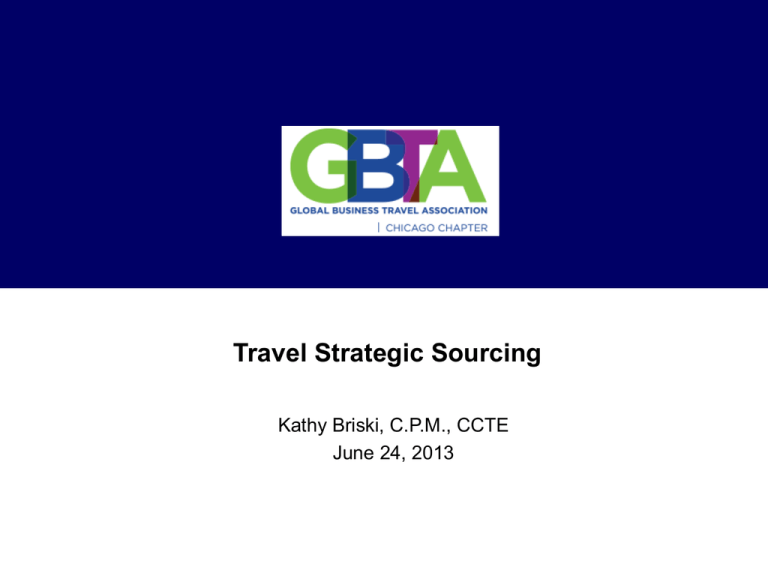
Travel Strategic Sourcing
Kathy Briski, C.P.M., CCTE
June 24, 2013
Global Procurement Processes
Day-to-Day Purchasing Process
Generate
Requisition
Approve/
Submit
Requisition
Process/
Submit
Order
Receive
Goods &
Services
Approve
Invoice
Process
Invoice &
Generate
Payment
Strategic Sourcing Process
Access
Opportunity
&
Establish
Team
Profile
Category
Internally
& Externally
Develop
Sourcing
Strategy
Conduct
Competitive
Exercise
w/ Approved
Suppliers
Create
Selection
Factors &
Evaluate
Suppliers
Negotiate
& Develop
Sourcing
Recommendaction
Implement
Agreements
Supplier Relationship Management Process
Define
Supplier
Evaluation
Criteria
Collect
Data
Conduct
Performance
Evaluation
Develop
Improvement
Strategy
Continuous
Improvement
Core Supporting Capabilities
Supplier
Scorecard
Savings
Management
Spend
Analysis
Knowledge
Management
Page: 1
Contract
Management
Catalog
Management
Strategic Sourcing Process Overview
ANALYSIS
STRATEGY
SUPPLIER SELECTION
IMPLEMENTATION
Strategic Sourcing Methodology
Assess
Opportunity
& Establish
Team
Activities
Assess
Opportunity
Obtain
Sponsorship
& ID Team
Deliverables or Tools
Create
Project
Plan
Project Plan
Analyze Current
Spend
Document
Requirements
Profile
Category
Internally &
Externally
Validate
Internal
Requirements
& Profile
Category
Develop
Sourcing
Strategy
Develop
Sourcing
Objectives
Create
Selection
Factors &
Evaluate
Suppliers
Create
Supplier
Selection
Criteria
Fast Track for Quick Savings
Build TCO
Model
Conduct
Industry
Analysis
Internal Category
Profile
TCO Model
Cost Reduction
Ideas
Industry Profile
Conduct
Competitive
Exercise w/
Approved
Suppliers
Complete
Traditional
RFP Process
- AND/OR Conduct
eAuction(s)
Develop
Sourcing
Strategies &
Tactics
Conduct
Supplier
Analysis
- AND/OR Collaborate w/
Incumbent
Supplier(s)
Sourcing
Strategy Plan:
Competitive
Supplier
Selection or
Existing
Supplier
Development
Supplier
Selection
Decision Matrix
RFPs / RFQs
RFIs (optional)
“Short List” of
Suppliers
Page: 2
eAuctions
Collaborative
Discussions
Negotiate &
Develop
Sourcing
Recommendaction
Implement
Agreements
Prepare FactBased
Negotiation
Packages
Implement
Agreements
and Monitor
KPIs
Negotiate
Agreements
Evaluate
Performance
and Develop
Suppliers
Fact-Based
Negotiation Packages
Finalized
Agreements
Supplier Negotiations
Presentation
Benefits
Realization
Sourcing
Recommendation
Continual
Supplier
Improvement
Strategic Sourcing Process Overview
ANALYSIS
STRATEGY
SUPPLIER SELECTION
IMPLEMENTATION
Strategic Sourcing Methodology
Assess
Opportunity
& Establish
Team
Profile
Category
Internally &
Externally
Develop
Sourcing
Strategy
Create
Selection
Factors &
Evaluate
Suppliers
Activities
Assess
Opportunity
Obtain
Sponsorship
& ID Team
Deliverables or Tools
Create
Project
Plan
Project Plan
Analyze Current
Spend
Document
Requirements
Page: 3
Conduct
Competitive
Exercise w/
Approved
Suppliers
Negotiate &
Develop
Sourcing
Recommendaction
Implement
Agreements
SAMPLE
High Level Travel Project Plan
Travel Workplan Review
April
May
June
July
August
September
Mobilization & Kick-Off
Category
Profile Internally &
Externally
Develop Strategy
Screen Suppliers &
Selection Factors
Conduct Competitive
Exercise
Negotiate & Develop
Sourcing
Recommendation
Implement Agreement
4
SAMPLE
Travel Category Opportunity
Confirmation of Sourceable Spend
Category Opportunity Baseline – Travel
Sourcing
Group
Category
Sub-Category
Addressable
Spend
%
Addressable
Sourceable
Spend
Est. Mid
Saving %
Est. Mid
Savings $
Travel
Airline
$6,000,000
100%
$5,500,000
3%
$165,000
Travel
Car Rental
$1,000,000
100%
$925,000
5%
$46,250
Travel
Hotel
$4,500,000
100%
$4,400,000
5%
$220,000
Travel
Agency - Agency Fees
$170,000
100%
$0
0%
$0
Travel
Demand Management
(Compliance)
N/A
SAMPLE
N/A
Key Travel Contracts and Expiration Dates
Preliminary Opportunities to Drive Accelerated Benefit
•Hertz Car Rental Agreement – Expiration Date: July 31, 2010
•Northwest Airlines Agreement – Expiration Date: November 30, 2010
•American Express Travel Agency Agreement – Expiration Date:
September 30, 2009 – Currently Extended until September 30, 2010,
with an additional 1 year extension (2011).
•Mandated Travel & Entertainment Policy
•Drive Demand Management (Compliance Behavior):
•On-Line Booking Tool
•Advance Ticket Purchase
•Non-Refundable Tickets
•Preferred Hotel usage
•Preferred Car Rental usage
•Hotel Competitive Bid
•Negotiate American Airlines contract
•Car Rental Competitive Bid
Page: 5
$700,000
Strategic Sourcing Process Overview
ANALYSIS
STRATEGY
SUPPLIER SELECTION
IMPLEMENTATION
Strategic Sourcing Methodology
Activities
Assess
Opportunity
& Establish
Team
Profile
Category
Internally &
Externally
Develop
Sourcing
Strategy
Create
Selection
Factors &
Evaluate
Suppliers
Validate
Internal
Requirements
& Profile
Category
Build TCO
Model
Deliverables or Tools
Conduct
Industry
Analysis
Internal Category
Profile
TCO Model
Cost Reduction
Ideas
Industry Profile
Page: 6
Conduct
Competitive
Exercise w/
Approved
Suppliers
Negotiate &
Develop
Sourcing
Recommendation
Implement
Agreements
SAMPLE
Total Cost of Ownership – Elements
Price for airfare, room rates and rental rates make up a portion of the TCO for Travel with
cost drivers laying hidden in process.
Air Ticket Cost
• Air Ticket Cost • Fuel Surcharges
• Taxes
• Security Fees
Ancillary Fees
• Baggage Fees • In Flight Internet
• Change Fees • Status Level
Airfare Cost
Nightly Room Rate
Price
Hotel Cost
Misc. Charges
Daily Rate
Total Cost
of
Ownership
Travel
Rental Car Cost
Fuel
Misc. Charges
• Upgrade Fees
• Energy Surcharge
• Internet
• Meals
• Parking
• Phone
• Fitness Center
• Daily Rate
• Taxes
• Self fill
• Fuel and Service Charges
• Fuel Purchase Options
•
•
•
•
Mileage Charge • Insurance
• Airport Fees
Vehicle Fees
• City Surcharge
GPS
Concession Fee Recovery
Labor Costs
• Time to register new online users
on Cliqbook
• Time to train new online users
Travel Policy
• Policy Enforcement
• Advance Booking
• Preferred Suppliers
Procurement
Process
Management Fees
Agency Cost
Copyright © 2007 Accenture All Rights Reserved.
• Room Rate
• Taxes
Support
• Online Booking
• Agent Assisted Booking
• Client Negotiated Airfare
Transaction Fee
• Emergency Travel Services
• Change Requests
7
SAMPLE
Industry Profile - Objective & Key Questions
Objective
Provide a detailed understanding of the current corporate travel industry as well as the forces
shaping future travel services. The results of this profile will shape Comerica’s travel Sourcing
Strategy.
Key Questions
How big is the industry?
Who are the major players?
How competitive is the market?
What are the key cost drivers?
Is the industry in a state of growth or decline?
What are the current pricing trends?
Page: 8
SAMPLE
Travel Scope
The travel industry encompasses a variety of different categories each grouped with an
NAICS (North American Industry Classification System) code.
In Scope
NAICS 481 – Transportation by Air
Key Points
4811 – Scheduled Air Transportation
481111 – Scheduled Passenger Air Transportation
NAICS 721 – Accommodation
7211 – Traveler Accommodation
721110 – Hotels and Motels
721110.1 Guestroom Rental
NAICS 5321 – Automotive Equipment Rental
53211 – Passenger Car Rental and Leasing
532111 – Passenger Car Rental (for business travel)
NAICS 561 – Administrative and Support Services
5615 – Travel Arrangement and Reservation Services
561510 – Travel Agencies (including Meetings & Events)
Source: http://www.bls.gov
Page: 9
• Scheduled passenger air
transportation, hotel, passenger car
rentals and meeting/event planning
services are in scope for travel
sourcing.
• Because of the existing relationship
with current travel agency and the
subsequent process standardization,
it does not make sense to fully source
the travel agency component of travel
at this time. However, there may be
components of the contract to
reevaluate.
• Meeting/Event Planning Services are
categorized under the same NAICS
code as Travel Agencies.
AIRLINE INDUSTRY – US Airline Mergers
•
In 2000, 10 airlines accounted for slightly more than 90% of available seat-mile capacity in the
United States. By early 2012, those 10 airlines, through mergers, were reduced to 5 airlines
controlling about 85% of the domestic passenger market. Moreover, American and US Airways is
currently merging —which would further reduce the number of airlines controlling the vast majority
of passenger ridership to only four.
2012 US Airlines Shares
Delta
United
Southwest
American
US Airways
JetBlue
Alaska
AirTran Corporation
SkyWest
ExpressJet
Other
16.3%
15.1%
15.0%
12.9%
8.1%
4.9%
3.8%
2.9%
2.3%
2.2%
16.5%
Source: Office of Inspector General, AVIATION INDUSTRY PERFORMANCE, A Review of the Aviation Industry, 2008–2011, Number: CC-2012-029 , Date Issued: September 24, 2012
RITA, Bureau of Transportation Statistics
BOEING PROPRIETARY
SAMPLE
Airline Industry: Overview
2012 Global Airline Industry Revenue reached $636 Billion. North America is the industry's
revenue leader, generating about 44.3% of industry revenue.
Key Points
Revenue in Billions
Annual Airline Industry Revenue
$538
$582
$493
$561
$590
$636
•
•
$660
•
•
2007
2008
2009
2010
2011
2012
2013F
•
•
2012 Revenues (in Billions)
$40
$35
•
$30
$25
•
$20
$15
•
$10
$5
$0
Source: Airlines for America: airlines.org, Airline Financials.com, IATA, Wikipedia
Page: 11
2012 Airline Industry Revenue reached $636 Billion.
North America is the industry's revenue leader,
generating about 44.3% of industry revenue.
United, Delta, and American are the market
leaders based on revenue
In 2012, United’s net income was $589M and Delta
earned $854M, while American lost $1.87 Billion.
Alaska Air earned $245M, Southwest $417M, US
Airways $637M and Jet Blue earned $376M.
Business travel represents 35% of airline’s revenue
From 2000 – 2010, US Airlines improved their ontime arrivals from 72.6% to 79.8%.
From 2000 – 2010, airlines reduced greenhouse
gas emissions by 10%, while transporting 15%
more passengers and cargo.
Federal taxes constitutes $61 or 20% of a typical
$300 domestic round trip ticket.
In 2013, Airfare Average Ticket Prices are expected
to be:
− Up 2-4% in the US
− Up 1-3% in Europe
− Up -1 to 4 % in Asia-Pacific (5-10% in India)
− Up 5-10% in Latin America
− Up 2-4% in Africa
− Up 2-4% in Middle East
Airline Industry: PPI (Producer Price Index) – Scheduled Passenger Air Transportation
The PPI (measures average change in prices over time) for passenger air transportation. For 2012 the average amounted to
285.0 which represents a gain of 9.5% from 2011.
2013 Data
300
286.6
285.0
282.0
Producer Price Index
280
273.5
278.7
281.2
276.9
257.1
260
254.6
240
234.5
235.9
229.6
220
205.7
205.8
217.1
200.6
200
200.4
180
186.5
NAICS 481111 February– Mary 2013 Preliminary. All indexes are subject to revision four months after original publication.
Source: http://www.bls.gov/ppi/
SAMPLE
Airline Industry: Cost Drivers
Top 3 Drivers Account For 64.3% of Total Airline Costs.
Key Points
2012 Cost Drivers
• The top three cost drivers for ninety
five percent of the world’s airlines,
are: fuel, personnel and the cost of
aircraft, which together account for an
average of 64.3% of an airline’s total
cost structure.
• Dependence on oil production, labor
agreements and a duopoly in aircraft
manufacturing prevent airlines from
having any substantive impact on
these cost drivers.
• With revenues fixed by competitive
ticket pricing and the majority of their
costs out of their control, airlines are
challenged to maintain earnings and
gain competitive advantage by
controlling less than 35% of their cost
structure.
Source: www.rajcoaviation.com
Page: 13
SAMPLE
Airline Industry: Jet Fuel Costs
Fuel is one of the largest cost contributor to airlines’ operating costs.
Key Points
Increasing Jet Fuel Costs
•
$140
$130
$129
$120
Average Price Per Barrel
$120
$100
$83
$80
•
$91
$88
$80
$70
$60
•
$49
$40
$33
$34
$20
$36
$30
•
$0
2000 2001 2002 2003 2004 2005 2006 2007 2008 2009 2010 2011 2012
•
•
Sources: Airlines for America: www.airlines.org, www.bts.gov, www.iata.org
Page: 14
Historically jet fuel expenses have ranged
between 10% and 15% of U.S passenger
airline operating costs, but in 2008 the cost
of fuel was between 30% – 40% of total
operating expenses for most carriers. For
2012, average price of jet fuel was $129.60
per barrel.
The most reasonable explanation for such
high prices is tight supply and counteracting
the weak economic conditions
In 2008 and now in 2013, every dollar
increase per barrel (42 gallons) drove an
additional $448M in fuel expenses to
carriers’ bottom lines
From 2000 – 2010, US airlines carried 15%
more traffic while using 2.1 Billion fewer
gallons of fuel.
In 2011, US passenger and cargo airlines
spent $50.5 Billion on fuel, up $11.7 Billion
from 2010.
For 2013 jet fuel prices averaging $124.60
per barrel
Airline Industry: Air Travel Price Index
SAMPLE
The cost of air travel have been very volatile over the past several years. The cost of airfare flying into Chicago – O’Hare
has been consistent with the U.S. average while Chicago – Midway has been consistently lower than the U. S. average.
Air Travel Price Index for Chicago1
Key Points
•
U.S.-Origin ATPI
Chicago - O'Hare
Chicago - Midway
$430
•
Average Air Fares
$380
$330
$280
•
$230
$180
2003 Q1 2004 Q1 2005 Q1 2006 Q1 2007 Q1 2008 Q1 2009 Q1 2010 Q1 2011 Q1 2012 Q1
•
1
The air travel price index measures the percents change over time in prices paid by travelers.
•
Sources: Bureau of Transportation Statistics, AMEX 2013 Forecast, CWT 2013 Forecast,
Advito’s 2013 Forecast, Airlines for America: www.airlines.org
Page: 15
The cost of air flying into Chicago –
O’Hare has been consistent with the U.S.
average while Chicago – Midway has
been consistently lower than the U.S.
average.
In 2013, Airfare Average Ticket Prices are
expected to be:
−Up 2-4% in the US
−Up 1-3% in Europe
−Up -1 to 4 % in Asia-Pacific (5-10% in
India)
−Up 5-10% in Latin America
−Up 2-4% in Africa
−Up 2-4% in Middle East
Airlines found several ways to grow
revenue without raising fares – a la carte
pricing: from charging for select coach
seat assignments, boarding after elite
status members, baggage fees and fuel
surcharges and possibly using restrooms!
In 2011, US airlines posted the lowest
annual rate of mishandled baggage ever
recorded.
In 2012, the airline industry earned
approx. $36.1 billion in additional ancillary
fees, an increase of 11.3% from 2011
SAMPLE
Airline Industry: Baggage Fees
Ranking *
Airline
2007
2008
2009
2010
2011
2012
1
Delta
96,546
177,063
481,719
952,250
863,608
865,879
2
United
52,002
132,994
268,977
313,207
276,817
705,547
3
American
124,538
277,991
475,184
580,663
563,465
557,385
4
US Airways
27,738
187,082
432,280
513,623
506,339
516,206
5
Spirit
46,848
81,503
133,970
168,229
6
Alaska
16,151
22,028
58,669
108,997
157,013
151,475
7
Southwest
20,799
25,266
26,983
29,787
32,035
144,475
8
Allegiant Air
44,095
55,325
53,562
89,556
9
JetBlue
16,416
35,308
53,267
57,019
64,078
70,788
10
Frontier
4,618
15,156
55,160
62,115
54,862
70,173
11
Hawaiian
4,505
11,627
38,186
54,008
56,590
67,829
12
Virgin America
231
2,569
19,364
36,075
33,482
57,410
13
Continental
42,844
97,524
254,488
341,585
353,416
14
Air Tran
9,168
29,401
145,983
152,148
164,670
TOTAL
415,556
1,014,009
2,401,203
3,338,305
3,313,907
Source: www.bts.gov
Page: 16
3,464,952
SAMPLE
Airline Industry: Cancellation/Change Fees
Ranking *
Airline
2007
2008
2009
2010
2011
2012
1
Delta
16,331
18,927
406,039
698,611
766,795
778,398
2
United
331,193
354,471
309,866
321,539
324,129
660,943
3
American
469,883
449,899
471,369
495,158
517,708
4
US Airways
68,304
248,840
253,077
275,643
297,693
5
JetBlue
123,468
121,273
113,997
124,536
133,771
6
Southwest
7
Virgin America
8
Spirit
9
Alaska
10
74,472
32,470
9,761
12,866
18,151
15,851
30,644
21,514
23,561
23,120
25,927
27,763
54,700
67,077
60,590
50,357
10,598
23,210
Hawaiian
21,801
25,159
23,546
18,192
17,356
18,285
11
Frontier
33,081
34,279
21,494
16,685
16,562
14,217
12
Air Tran
20,820
24,339
42,766
50,416
49,964
10,400
13
Continental
227,868
237,446
249,831
1,948,608
2,272,960
2,372,350
TOTAL
943
553,341
1,217,182
* Airlines ranked by 2012 reservation cancellation/change fee revenue, dollars in thousands (000)
Source: www.bts.gov
Page: 17
2,545,502
Airline Industry: Price of Air Travel versus Other Goods & Services
SAMPLE
Shown in their original values, facilitating comparisons with other goods & services versus the price of air travel and with
movements in the U.S. Consumer Price Index (CPI). CPI is defined as a measure that examines the weighted average
of prices of a basket of consumer goods and services.
Price of Air Travel Versus Other Goods and Services
Product (Unit)
2000
2012
2012 vs 2000
Prescription Drugs (Index) 2
Major League Baseball (MLB) Game Ticket 9
Unleaded Gasoline (Gallon) 3
New Single Family Home 4
CPI (All items) 2
$3,508
$16,072
$49.35
285.4
$8,655
$29,056
$78.38
440.2
147%
81%
59%
54%
$16.22
$1.51
$169,000
172.2
$25.98
$3.64
$240,000
229.6
66%
141%
45%
33%
Movie Ticket 5
First-class Domestic Stamp 6
Whole Milk 2
Grade-A Large Eggs (Dozen) 2
Air Travel: Round Trip Domestic Fare 7
Air Travel: Round Trip International Fare 7
$5.39
$0.33
156.9
$0.91
$314.46
$935.26
$7.96
$0.45
211.27
$1.84
$357
$1,209
48%
36%
35%
102%
14%
29%
129.6
49.9
126.3
5.4
-3%
-89%
College Tuition: Public (Year) 1
College Tuition: Private (Year) 1
National Football League (NFL) Game Ticket 8
Apparel: Clothing/Footwear/Jewery (Index) 2
Television (Index) 2
1 The College Board - based on beginning of academic year
2 U.S. Bureau of Labor Statistics - including hedonic "quality-change' adjustments
3 U.S. Department of Energy - Monthly Energy Review, Table 9.4
4 U.S. Census Bureau - median value
5 National Association of Theatre Owners
6 U.S. Postal Service - Publication 100
7 ATA via U.S. bureau of Transportation Statistics - exludes taxes; first column reflects 1979 (1978 data not available)
8 National Football League, average nonpremium ticket
9 Major League Baseball, average nonpremium ticket
Sources: Airlines for America: www.airlines.org
Page: 18
SAMPLE
Hotel Industry: Overview
2012 Global Hotel Industry Revenue reached $580 Billion. The US Hotel Industry Revenue
reached $128 Billion in 2012.
Key Points
2012 Global Revenue (in billions)
$14.00
$12.00
•
$10.00
$8.00
•
$6.00
$4.00
$2.00
$0.00
•
•
US Market Segmentation
Personal or
f amily travelers
25%
21%
•
Business
travelers
Vacation
travelers
26%
28%
Source: www.IBISWorld.com, Smith Travel Research
•
Conf erence
travelers
Page: 19
2012 Global Hotel Industry Revenue reached $580
Billion. The US Hotel Industry Revenue reached
$128 Billion in 2012
In 2013 global hotel revenues are estimated to grow
2.2 % to $592.6 billion. Over the five years to 2017,
revenue is projected to increase at an average
annual rate of 2.3% to $650.9 billion. This will result
from growth in business and pleasure travel, and
rising room rates.
In 2013, US industry revenue is expected to
increase 3.5% to $127.8 billion.
Global industry profit is estimated to account for
10.8% of total industry revenue in 2012, up from an
estimated 6.5% in 2009, and similar to pre-2008
levels. US industry profits in 2013 are expected to be
9%.
Smith Travel Research is projecting increases in all
three key performance metrics during 2013:
Occupancy is expected to rise 0.8% to 61.9%,
Average Daily Rate (ADR) will increase 4.6% to
$111.27 and Revenue Per Available Room
(RevPAR) is expected to grow 5.7% to $68.86.
Major US market segmentation: 28% transient
business travelers and 25% conference travelers.
Hotel Industry: Chains / Brands
SAMPLE
The majority of the global branded properties and revenue are mostly located in North America,
Chain Portfolio by Hotels & Rooms
Key Points
Total Network
(Rooms/Hotels)
Main
Footprint
Brands &
Segment
647,161 R
Americas: 68%
7 brands
from midscale to luxury
Americas: 83%
12 brands
from budget to upscale
Americas: 85%
15 brands
from midscale to luxury
Americas: 86%
10 brands
from economy to luxury
EMEA: 56%
10 brands
from budget to luxury
Americas: 87%
11 brands
from budget to luxury
Americas: 61%
9 brands
from midscale to luxury
4,437 H
612,735 R
7,207 H
605,141 R
3,474 H
~ 600,000 R
~ 3,600 H
507,306 R
4,229 H
495,145 R
6,142 H
301,700 R
1,027 H
•
•
•
•
Brands by Service Level
•
Source: PWC Hospitality Directions, Smith Travel Research, CWT Hotel
Solutions, Business Travel News, IBISWorld
Page: 20
The majority of the global branded
properties and revenue are mostly
located in North American
Major revenue for global chains (such as
Marriott, Hilton, etc) is from franchise
and management fees.
Business travelers, including executives,
are shifting from luxury hotels to more
moderate mid-priced hotels
Hotel taxes, usually a combination of
sales and occupancy taxes along with
the occasional flat fee, range from 10%
to more than 18%.
Hotel costs represent the single largest
component of non-air expenses, about
43% of the travel dollar
Hotel Chain Scales
Chain Scale
Brand Name
Luxury
Upper Upscale
Upscale
Midscale
For Domestic Hotel
Bookings (2012) :
Economy
Ex-Upscale
Ex-Midscale
Ex-Economy
Total Tracked
Spend: $XXM
46% of spend in
Upper Upscale.
Average Nightly
Rate: $XXX
21% of spend in
Upscale. Average
Nightly Rate:
$XXX
Hotel Industry: PPI – Hotels & Motels, Guestroom Rentals
The PPI for hotel rooms have fluctuated during 2012 due to pressures from both buyers and sellers. The 2012
average ended at 131.4 indicating rates are raising.
140.0
2013 Data
134.8
135.0
131.4
130.2
Producer Price Index
129.7
130.0
126.8
124.1
124.3
125.0
125.1
120.0
116.4
115.0
111.7
110.0
105.0
100.0
104.5
100.0
NAICS 721110.1 February – May Preliminary. All indexes are subject to revision four months after original publication.
Source: http://www.bls.gov/ppi/
126.7
123.5
130.2
Hotel Industry: Cost Drivers
SAMPLE
Over 80% of costs in the hotel industry is distributed among four categories: (1)
administrative overhead, (2) labor, (3) repairs and maintenance, and (4) food and beverage.
Operating Cost Drivers
2013 US Cost Structure
2012 Global Cost Structure
100%
100%
9.0%
10.8%
90%
90%
80%
11.6%
13.1%
80%
2.0%
4.8%
70%
7.6%
2.1%
4.8%
4.9%
Prof it
70%
60%
6.7%
Advertising
60%
Depreciation
50%
50%
Other
Other
32.3%
Rent & Utilities
Purchases
30%
Wages
Wages
20%
20%
10%
Depreciation
40%
Rent
Purchases
30%
Advertising
38.1%
Utilities
40%
Prof it
25.3%
10%
0%
0%
Source: www.IBISWorld.com
Page: 23
26.9%
Hotel Industry: 2013 Expected Changes in
Room Rates
Expected Changes in Hotel Prices
Expected Changes in Hotel Prices
Mid-Range
Hotel Forecast
Upper-Range Hotel
Forecast
Mid-Range Hotel Forecast
North America
2-7%
4-9%
UAE
USA
3-7%
4-9%
South Africa
Canada
0-4%
0-4%
Mid-Range Hotel Forecast
Upper-Range Hotel Forecast
Upper-Range Hotel Forecast
-3 to 6.5%
-3 to 6.5%
3-6%
3-7%
Mid-Range Hotel Forecast
Upper-Range Hotel Forecast
Asia Pacific
0-4%
2-7%
Latin America
4-7.5%
3-6.5%
Australia
0-5%
0-5%
Brazil
4.5-8.5%
5-9%
China
0-5%
2-7%
Argentina
4-6.5%
3-6.5%
Hong Kong
3-8%
3-8%
Mexico
-1 to 3%
-1 to 3%
India
0-5%
0-5%
Chile
1.5-5.5%
1.5-5.5%
Japan
-1 to 2%
-1 to 2%
Singapore
3-7%
3-7%
South Korea
3-8%
3-8%
Mid-Range Hotel Forecast
Germany
France
1.5-4.5%
Upper-Range Hotel Forecast
1.5-3.5%
2-5.5%
2-4.5%
UK
0-5%
-2 to 4%
Italy
-0.5 to 2.5%
-3 to 2%
Netherlands
2-6%
1-6%
Sweden
0-4.5%
1-5.5%
Norway
1.5-4.5%
1.5-5%
Finland
3.5-6.5%
3-5%
Denmark
0-2.5%
0.5-2.5%
Russia
6.5-11%
6.5-12%
SAMPLE
Car Rental Industry: Overview
Global industry spend is $30.5 billion of which 34% is business travel
Key Points
•
•
•
•
•
•
•
Source: IBISWORLD, Auto Rental News, Business Travel News
Page: 25
Global industry spend is $30.5 Billion of
which 34% is business travel
The industry is segmented by business
travelers, leisure travelers, car leasing
and car sharing
Leisure market has grown larger than
corporate business market
Industry revenue is forecasted to
increase 2% for the next 5 years
High fuel cost is impacting industry as
customers, especially leisure travelers,
are finding other alternatives (public
transportation)
Hertz and Avis expanding off-airport
locations to compete with Enterprise
Car rental industry adjusted to global
recession better than other travel
industry categories. They can “right”
size fleet to meet demand by disposing
vehicles quickly and reduce costs.
Rental Car Industry: PPI – Passenger Car Rental
The PPI for passenger car rentals has gone up 22% from 2005 to 2008 indicating increased fleet and fuel cost.
In 2008 and 2009, prices have slightly increased and in 2011 and 2012 prices dropped significantly.
Producer Price Index
125.0
119.3
120.0
117.8
116.8
118.1
115.0
2013 Data
111.5
110.0
109.6
106.9
108.8
106.0
104.8
104.4
105.0
105.4
102.6
100.0
NAICS 532111 February – May 2013 Preliminary. All indexes are subject to revision four months after original publication.
Source: http://www.bls.gov/ppi/
102.9
104.6
102.9
103.0
US Car Rental Industry - Segmentation
Services Segmentation
Key Findings
Car sharing
6%
Car leasing
19%
•
Leisure car rentals have been making
up a larger portion of industry revenue
over the last few years, largely in
response the sizeable drop in
business travel, which happened as a
result of the economic downturn.
•
Car leasing involves paying an upfront lease fee plus fixed monthly
payments in return for taking
possession of and operating a car for
12 months or more. This industry does
not include cars leased to purchase or
leased to own.
•
The off-airport market, sometimes
called the local market, includes car
sharing; insurance replacement, and
leisure and business rentals
independent of the airport market.
Leisure car
rental
41%
Business
car rental
34%
Market Segmentation
Leisure
travelers at
airports
35%
Business
travelers at
airports
30%
Off-airport
market
35%
Page: 27
SAMPLE
Car Rental Industry: Market Share
The U.S. car rental market is highly consolidated among a small number of major players and is getting smaller.
Key Points
Top 4 Car Rental Companies By Revenue
•
$18.0
800,000
$16.0
700,000
$14.0
600,000
$12.0
500,000
$10.0
400,000
$8.0
300,000
$6.0
$4.0
200,000
$2.0
100,000
$0.0
0
Enterprise
Hertz
Avis
2012 Revenue ($B)
After Hertz’s purchase of Dollar Thrifty, the top three rental
car companies will make up 95% of the total on-airport US
car rental industry revenues
Suppliers offer different brands that focus on specialized
markets:
•
Corporate Traveler – On-airport convenience –
Hertz, Avis and National
•
Leisure Market – On/Off-airport Budget, Dollar
Thrifty, and Enterprise
Additional Non-US regional players include:
•
Europcar (Europe and Asia Pacific)
•
Sixt (Germany and EMEA)
In high risk countries such as India, China, Thailand, Latin
America, etc. the business model is to rent a car with
driver. Cost is less than a chauffer / limo as a typical rental
vehicle is used
In the past 4 years, major car rental companies trimmed
fleets from a total of about 2 million cars to about 1.3
million
Car rental companies have implemented a variety of new
ancillary fees to help preserve some of the lost revenue in
recent times, such as tacking on fees to extend a
reservation, eliminating 60 minute grace period, or
increasing the cost of a two-day rental
“Virtual rental technology” – enables customers to reserve,
rent, access and return cars just about anywhere. ZipCar,
WeCar, Connect.
•
Cars in Service (K)
2012 Revenue ($B)
2012 US Revenue & Cars in Service
•
•
Dollar
Thrif ty
•
Cars in Service
•
US Market Share by Revenue
2%
7%
Hertz
47%
18%
•
Enterprise
6%
Avis
•
Dollar Thrifty
20%
Independents
Other
Source: www.autorentalnews.com, Business Travel News Corporate Travel Index 2012
Page: 28
It is forecasted that that base rates will decline on average
between -1.5% to -2% for business travel rental cars in the U.S.
next year. However, ADR will increase by 1% to 2%, due to
slight increases in ancillary fees, taxes, other fees, vehicle
license fees (VLFs), and energy recovery fees.
Car Rental Industry: Cost Drivers
SAMPLE
Over 90% of costs in the car rental industry is distributed among four categories: (1)
Purchases, (2) Other, (3) Depreciation, and (4) Wages.
Operating Cost Drivers
Key Findings
• The industry have slowly recovered as the demand
for air travel, which is the industry’s primary revenue
source, started to increase as of 2010:
• Profit margins turned positive again in 2010, growing
to 3.5% in 2012.
• It is estimated that in 2012 the industry grew 5.6%
and reached a revenue level of $33.7 billion.
• In 2013, industry revenue is expected to grow 3% to
$34.7 billion. Car rental companies are forecast to
purchase more new cars in 2013 for two reasons.
• The anticipated increase in the number of rental
customers will force companies to field a larger
rental fleet.
• Companies will likely replace older cars with new
cars after letting the average age of their fleets rise
to save money.
• Although the industry’s future looks brighter, rising
gas prices may slow the recovery. As such, revenue
is forecast to grow at an annualized rate of 2.8%
from 2012 to 2017 to $38.6 billion.
Source: www.ibisworld.com, Auto Rental News
Page: 29
Travel Management Industry: Overview
The Top 50 travel management companies represent over $155 billion in sale revenue
2011 Top 5 (over $1B in revenue) Travel
Management Co’s By Revenues
Key Points
•
$30
•
2011 Revenues (in Billions)
$25
$20
•
$15
$10
$5
•
•
$0
•
•
Source: www.travelweekly.com Travel Weekly Power List 2012, www.bts.gov
The top 50 travel management
companies represent over $160 billion in
sales revenue in 2011.
Five companies registered more than
$20 billion in sales, including a
snowballing Priceline, which showed
significant increases each year.
There were 16 listees with sales of more
than $1 billion, up from 14 last year.
Expedia, Orbitz, Priceline, AAA Travel,
and Travelong receive 90% or more
sales revenue from the leisure market.
Many of the listees registered surges in
year-over-year sales, a couple by
acquisitions but most by generating
additional revenue from existing clients
or winning new clients.
AMEX regained top stop over Expedia in
2011 by a slim margin.
It was just announced that BCD was
purchasing Travelocity
TMC Industry: PPI – Travel Agencies
The PPI for travel agencies has gone down 13% since its high in 2001 (due to 9/11 and the commencement
of the on-line booking tool), but has risen since and has hit its 2007 high once again..
125.0
Produceer Price Index
123.3
121.8
120.0
2013 Data
114.3
115.0
113.2
113.0
114.0
111.5
111.5
112.5
111.7
113.8
112.4
110.0
108.6
107.4
105.0
NAICS 561510 February– May 2013 Preliminary. All indexes are subject to revision four months after original publication.
Source: http://www.bls.gov/ppi/
113.4
113.0
114.6
113.8
SAMPLE
Appendix: Data Sources
•
•
•
•
•
•
•
•
•
•
•
•
•
•
•
•
•
•
•
•
•
•
•
•
•
•
•
•
Advito’s 2013 Forecast
Airlines for America, www.airlines.org
AirlineFinancials.om
AMEX Business Travel 2013 Forecast and Trends
ATWOnline, www.atwonline.com
Auto Rental News
Bureau of Labor Statistics, www.bls.gov
Bureau of Transportation Statistics, www.bts.gov
Business Travel News
CWT Hotel Solutions
CWT 2013 Forecast
Egencia 2013 Forecast
Forbes, www.forbes.com
Hoovers Online, www.hoovers.com
IATA (International Air Transport Association) & World Air Transport Statistics (WATS 2006)
www.ibisworld.com
Global Business Travel Association, www.gbta.org
OneSource Inc., www.onesource.com
Power List 2012, www.travelweekly.com
Pwc Hospitality Directions
Rajcoaviation.com
Smith Travel Research Data
The Transnational.travel
Travel Daily News, www.traveldailynews.com
Travel Procurement
Travel Weekly, www.travelweekly.com
Wikipedia
Wikiinvest
Page: 32
Strategic Sourcing Process Overview
ANALYSIS
STRATEGY
SUPPLIER SELECTION
IMPLEMENTATION
Strategic Sourcing Methodology
Assess
Opportunity
& Establish
Team
Profile
Category
Internally &
Externally
Develop
Sourcing
Strategy
Create
Selection
Factors &
Evaluate
Suppliers
Deliverables or Tools
Activities
Develop
Sourcing
Objectives
Develop
Sourcing
Strategies &
Tactics
Sourcing
Strategy Plan:
Competitive
Supplier
Selection or
Existing
Supplier
Development
Page: 33
Conduct
Competitive
Exercise w/
Approved
Suppliers
Negotiate &
Develop
Sourcing
Recommendation
Implement
Agreements
Sourcing Strategies & Tactics
Several sourcing strategies can be pursued, either separately or together.
— Possible Sourcing Strategies —
STRATEGIC
RELATIONSHIP
Establish integrated
or close relationships
with suppliers where
both buyer and
supplier work
together to share
information,
collaborate, and
further each partner’s
goals
PROCESS
IMPROVEMENT
Identify opportunities
to standardize and
streamline business
processes that will
result in improved
quality, reduced cycle
times, and lower total
cost of ownership
Strategic
Relationship
Process
Improvement
Best Price
Analysis
Commodity
Sourcing
Strategy
Evaluate and model
all costs and use
negotiation tactics
that increase
transparency and
maximize competition
Demand
Management
Volume
Leveraging
VOLUME CONCENTRATION
Aggregate like goods and/or services
across organizational units in order to
increase negotiation leverage and negotiate
better pricing, and terms and conditions
Page: 34
BEST PRICE
ANALYSIS
DEMAND
MANAGEMENT
Address factors such
as standards,
requirements, and
policies to reduce
costs related to
internal demand
SAMPLE
Strategy Considerations
•
Company should examine current travel policies. Enforcement of on-line booking tool, advance
booking, preferred hotels and other travel guidelines will result in significant savings.
•
Because of the relative small air travel spend compared to other companies, in addition to moving
corporate headquarters to Dallas while still maintaining their Detroit area locations, Company
should consider focusing hard dollar airline discounts with one or two major carriers supporting
both markets. Furthermore, Company should consider exploring additional benefits for their
secondary markets
•
Company should re-examine their current preferred hotel program and consolidate markets and
room nights to leverage buying power
•
Company should leverage hotel spend for meetings/events in negotiating hotel rates for transient
travel
•
Preferred car rental utilization is “best in class”, therefore consider a competitive bid to leverage
utilization
•
Company may consider utilizing teleconferencing as an alternative to reduce their overall travel
usage
Page: 35
SAMPLE
Sourcing Strategy: Airlines
•
•
•
•
•
•
•
•
Current State
Travel policies located in Accounts Payable
Expenditure Manual – No enforcement
All departments using one travel agency,
however suspect that some Southwest
bookings are going directly to Southwest.com
Travel compliance is not be monitored
Recently moved corporate headquarters from
Detroit, MI to Dallas, TX
Top 3 airline spend: Northwest, American and
Southwest
Current contract with Northwest only (no
discount in Tier 3 and high market share
commitment)
70% of air spend in Tier 3
Some international air spend – about 15%
Sourcing Recommendation
• Create separate travel policy with management
enforcement
• Enter into negotiations with Northwest (current
contracted supplier) and American Airlines. In
addition, pursue possible corporate deal with
Southwest Airlines.
• Stimulate competition between Northwest
and American Airlines in multi-hub city pairs
• Stimulate competition between Northwest
and American Airlines for international air
spend
• Negotiate with Southwest and determine if
market share can support a formal corporate
agreement
• Market dynamics suggest a 2 year contract
Results
• Separate travel policy resulting in improved compliance
• Discount in Tier 3 level pricing
• Capture all Southwest spend
Page: 36
SAMPLE
Sourcing Strategy: Hotels
•
•
•
•
•
Current State
Travel policies located in Accounts Payable
Expenditure Manual – No enforcement
All departments using one travel agency, however
suspect that some hotel bookings are being
booked directly with hotel
Travel Agency manages and negotiates hotel
program
Large number of properties are being utilized in top
city markets (e.g. 75 hotels were utilized in the
Detroit (and surrounding) area in the last 12
months)
Cities are classified as Room Nights per City:
• Tier 1 (approx. 200+ Nights): 45% of hotel
spend in 12 market areas
• Tier 2 (<200 Nights): 55% of hotel spend in
the rest of the market area
Sourcing Recommendation
• Create separate travel policy and enforcement of
policy
• Tier 1: Issue a Request for Proposal to the
existing supply base as well as comparable
properties in defined geographies.
• Consolidate volume to increase bargaining
power
• Minimize number of options available in each
geography
• Pursue value-added amenities at no
additional cost
• Tier 2: Utilize Travel Agency rates and drive
volume to those properties with the lowest rates
Results
• Separate travel policy and enforcement which will result in improved compliance
• Competitive room rates in preferred cities
• Strategically selected properties by geography which will increase preferred property usage
Page: 37
SAMPLE
Sourcing Strategy: Car Rentals
•
•
•
•
•
Current State
Travel policies located in Accounts Payable
Expenditure Manual – No enforcement
All departments using one travel agency for
booking car rentals, however some spend is
being booked via another source
97% of the car rental spend is with one
preferred supplier
Over 75% of car rental returns are subject to
refueling charges
The top 15 cities, by volume, represent 78% of
the rental car spend
Sourcing Recommendation
• Develop and implement one travel policy for all
departments
• Issue a Request for Proposal to the top 5 rental
car companies
• Consolidate volume from all sources to
increase bargaining power
• Request pricing for one primary and one
primary and one secondary supplier
relationship
• Negotiate refueling charges, if possible
• Negotiate city surcharges for the top 15
cities, by volume
• Market dynamics suggest a 2 year contract with
the option for a 1 year extension
Results
• One travel policy for all departments resulting in capturing the non-compliance that is being done
• Award contract to one primary or one primary and one secondary supplier, whichever is more
advantageous
Page: 38
Category Strategy Deliverable
SAMPLE
Perform pricing exercise to include primary and primary/secondary considerations, include cargo
van/truck rental spend and negotiate additional concessions such as better rebate terms, lower
city surcharges and flat rate refueling charge.
Savings
Opportunity
Proposed Strategy
Expected Outcome
Volume
Concentration
Consolidate all OpCo car rental spend.
Leveraging buying power across all OpCo’s to maximize
savings.
Primary and
Secondary
Considerations
Pricing exercise to include using one primary vendor
only or having one primary and one secondary vendor
for car rentals.
Award business to one primary only, or one primary
and one secondary vendor, whichever is more
advantageous.
Service
Consolidations
Increase total spend to include cargo van/truck rental
business to leverage buying power with Enterprise and
Budget.
Enterprise to acknowledge additional spend with cargo
van/truck business which could help achieve additional
savings. Show Budget total spend across their
business units to obtain best pricing.
Additional
Concessions
Ask for additional concessions, including higher rebate,
lower city surcharges, lower refueling charges, lower
one-way and weekly rentals, and lower GPS rental fee.
Better rebate terms, possible lower city surcharges, and
flat rate refueling charge which amounts to additional
savings.
Demand
Management –
Global Policy
Develop a global travel policy for all OpCo’s to follow.
Consistency across all OpCo’s leads to demand
management savings.
Demand
Management –
Enforcement
Mechanism
Empower Global Travel Department to enforce global
travel policy with key OpCo team members.
Demand management savings in all areas, airline, hotel
and car rental.
Demand
Management –
Class of Service
Standardization
Standardize car rental class of service to “intermediate”
size car only.
Average daily car rental rate to decrease, providing
incremental cost savings to the program.
Page: 39
Strategic Sourcing Process Overview
ANALYSIS
STRATEGY
SUPPLIER SELECTION
IMPLEMENTATION
Strategic Sourcing Methodology
Deliverables or Tools
Activities
Assess
Opportunity
& Establish
Team
Profile
Category
Internally &
Externally
Develop
Sourcing
Strategy
Create
Selection
Factors &
Evaluate
Suppliers
Create
Supplier
Selection
Criteria
Conduct
Supplier
Analysis
Supplier
Selection
Decision Matrix
RFIs (optional)
“Short List” of
Suppliers
Page: 40
Conduct
Competitive
Exercise w/
Approved
Suppliers
Negotiate &
Develop
Sourcing
Recommendation
Implement
Agreements
SAMPLE
Car Rental Scorecard
Car Rental Company
37%
0%
2%
7%
9%
1%
12%
7%
63%
10%
33%
20%
Maximum
Points
572
0
35
100
131
21
185
100
954
154
500
300
100%
1526
Weight
Evaluation Criteria
I.
A.
B.
D.
E.
F.
G.
H.
II.
C.
Non-Pricing Components
Company Information
Rental Locations
Safety & Fleet
Services & Amenities
Billing
Top 15 Cities - Rental Locations
Top 15 Cities - Trans Method from Airport
Pricing Components
Additional Pricing Questions
National Daily Rental Rate
City Surcharge Rate
Page: 41
Person A
Score
549
0
35
78
130
21
185
100
666
92
437
136
Person B
Score
526
0
35
88
121
21
185
76
667
93
437
136
Person C
Score
538
0
35
76
121
21
185
100
671
97
437
136
1215
1193
1209
Total Score
538
0
35
81
124
21
185
92
668
94
437
136
1206
Strategic Sourcing Process Overview
ANALYSIS
STRATEGY
SUPPLIER SELECTION
IMPLEMENTATION
Strategic Sourcing Methodology
Assess
Opportunity
& Establish
Team
Profile
Category
Internally &
Externally
Develop
Sourcing
Strategy
Create
Selection
Factors &
Evaluate
Suppliers
Conduct
Competitive
Exercise w/
Approved
Suppliers
Complete
Traditional
RFP Process
Activities
- AND/OR Conduct
eAuction(s)
Deliverables or Tools
- AND/OR Collaborate w/
Incumbent
Supplier(s)
RFPs / RFQs
eAuctions
Collaborative
Discussions
Page: 42
Negotiate &
Develop
Sourcing
Recommendation
Implement
Agreements
Supplier Engagement Options
There are many ways to initially exchange information. While RFPs are often appropriate,
they are one of many means of engaging suppliers.
Direct Negotiations with an
Incumbent Supplier
Direct Negotiations with a
Target Supplier
Brainstorm with a Group of
Trusted Suppliers
Pre-Negotiation
Information
Exchange
On-Line Auctions
RFPs / RFQs
Should choose the method(s) that best meets both the Strategic Sourcing objective and the team
resource capacity
Page: 43
Strategic Sourcing Process Overview
ANALYSIS
STRATEGY
SUPPLIER SELECTION
IMPLEMENTATION
Strategic Sourcing Methodology
Profile
Category
Internally &
Externally
Develop
Sourcing
Strategy
Create
Selection
Factors &
Evaluate
Suppliers
Conduct
Competitive
Exercise w/
Approved
Suppliers
Negotiate &
Develop
Sourcing
Recommendation
Prepare FactBased
Negotiation
Packages
Activities
Assess
Opportunity
& Establish
Team
Deliverables or Tools
Negotiate
Agreements
Fact-Based
Negotiation Packages
Supplier Negotiations
Presentation
Sourcing
Recommendation
Page: 44
Implement
Agreements
Negotiations Approach – Discussion Points
SAMPLE
Based on a review of Company’s current program, contract terms, and stakeholder requirements, the
following improvement areas have been identified to maximize the annual incentive rebate.
Negotiation Point
Description
Supplier
Pricing, Incentive Rebate
Structure
• Size down the gap between rebate tiers to reduce the risk associated with dropping
to a lower tier. Closing the gap between tiers will inset Company to drive more
spend to Amex.
• Ensure incentive BPS earned at each tier are best in class for domestic and nondomestic spend.
• ABC
Pricing, Signing Bonus
• Reduce/eliminate minimum signing bonus *NACV thresholds (claw back clause) to
avoid refunding any portion of the $1M signing bonus paid to Company in 2008.
• Take a position which suggest Company is doing Amex a favor by offering them
other potential business. ABC should fight to keep this business considering
transition cost will be minimal for them, thus their margin will not be adversely be
effected.
• ABC
Pricing, Performance
Bonus
• Establish a realistic performance target based on the post spin *NACV, the current
(pre spin) performance target is too aggressive.
• Maximize the annual performance bonus.
• ABC
Pricing, Deductions
• Minimize consulting assessment expenses (hourly rate) and Membership Reward
(MR) fees which are deducted directly from the incentive rebate.
• Negotiate an annual credit which can be applied to consulting and MR expenses.
• ABC
Pricing, High ROC
Transactions
• Reduce the 50 BSP reduction on P-card transactions > $10K (Hi-ROC volume).
• Negotiate a buffer which can be applied to the Hi-ROC volume, i.e. request that the
BSP penalty apply only to Hi-ROC volume which exceeds a specified amount.
• ABC
*NACV – Net Annual Charge Volume (i.e. annual spend with Amex)
Page: 45
Negotiations Approach – Projected Targets
SAMPLE
Below are the projected results should Company be successful in driving ABC to the negotiation
points proposed. Total Savings is projected to be approximately $300-$600K.
SAMPLE
Strategy
Expected Benefits
Type
Savings ($)
LAS / BATNA
Key Enablers
Incentive Rebate Structure – fine
tune the incentive BSP tiers to
maximize the rebate received post
spin-off.
Financial
$200-$400K
• Focus on sizing down
the gap between rebate
tires.
• Put business out to bid
• Stakeholder buy-in
• Executive sponsorship
• Procurement Support
Performance & Signing Bonus –
adjust bonus targets to align with the
post spin-off spend portfolio. The
current targets are far to aggressive.
Financial
$100-$150K
• Concede to a reduction
in the performance
bonus if the target is
simultaneously reduced
• Mandate a reduction in
minimum thresholds for
signing bonus retention
• Stakeholder buy-in
• Executive sponsorship
• Procurement Support
Deductions – reduce the expense
subtracted from the *NACV and
deductions from the base incentive
rebate.
Financial
$0-$50K
• Focus on improving the
rebate earned on HighROC volume
• Dedicate a resource to
handle ad-hoc
assessment activities
• Stakeholder buy-in
• Executive sponsorship
• Procurement Support
Total
$300-$600K
*NACV – Net Annual Charge Volume (i.e. annual spend with Amex)
Page: 46
Strategic Sourcing Process Overview
ANALYSIS
STRATEGY
SUPPLIER SELECTION
IMPLEMENTATION
Strategic Sourcing Methodology
Assess
Opportunity
& Establish
Team
Activities
Assess
Opportunity
Obtain
Sponsorship
& ID Team
Deliverables or Tools
Create
Project
Plan
Project Plan
Analyze Current
Spend
Document
Requirements
Profile
Category
Internally &
Externally
Validate
Internal
Requirements
& Profile
Category
Develop
Sourcing
Strategy
Develop
Sourcing
Objectives
Create
Selection
Factors &
Evaluate
Suppliers
Create
Supplier
Selection
Criteria
Fast Track for Quick Savings
Build TCO
Model
Conduct
Industry
Analysis
Internal Category
Profile
TCO Model
Cost Reduction
Ideas
Industry Profile
Conduct
Competitive
Exercise w/
Approved
Suppliers
Complete
Traditional
RFP Process
- AND/OR Conduct
eAuction(s)
Develop
Sourcing
Strategies &
Tactics
Conduct
Supplier
Analysis
- AND/OR Collaborate w/
Incumbent
Supplier(s)
Sourcing
Strategy Plan:
Competitive
Supplier
Selection or
Existing
Supplier
Development
Supplier
Selection
Decision Matrix
RFPs / RFQs
RFIs (optional)
“Short List” of
Suppliers
Page: 47
eAuctions
Collaborative
Discussions
Negotiate &
Develop
Sourcing
Recommendation
Implement
Agreements
Prepare FactBased
Negotiation
Packages
Implement
Agreements
and Monitor
KPIs
Negotiate
Agreements
Evaluate
Performance
and Develop
Suppliers
Fact-Based
Negotiation Packages
Finalized
Agreements
Supplier Negotiations
Presentation
Benefits
Realization
Sourcing
Recommendation
Continual
Supplier
Improvement
SAMPLE
Implementation Plan Overview
An effective implementation plan consists of several key components necessary to ensure
rapid and complete benefits realization from the new supply arrangement(s), and to follow
through on agreed to parameters during contract negotiations.
– Overview of Implementation Plan Components –
Plan Component
Description
Transition Plan
Shift from old supply agreements to new ones.
May or may not involve switching suppliers.
Communication
Plan
Inform the user community of the outcome of the strategic sourcing effort.
Specify to users how they are impacted and what actions they are required to take
as a result of the strategic sourcing effort.
Highlight all benefits that users may derive from the new supply arrangements.
Compliance Plan
Determine how compliance to new supply arrangements will be enforced (if
possible).
Closely linked to the “Communication Plan”.
Benefits Tracking &
Reporting Plan
Measure benefits resulting from new supply arrangements relative to targets
Report to senior management on both status and any necessary actions required to
improve benefits realization.
Performance
Management Plan
Ensure that suppliers are performing along key metrics as required by the contract.
Put in place a regular communication vehicle with suppliers to drive improvements
in supplier performance.
Page: 48

